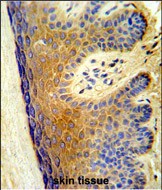ALOX15B Antibody (C-term)
Purified Rabbit Polyclonal Antibody (Pab)
- 产品详情
- 实验流程
- 背景知识
Application
| WB, IHC-P, E |
|---|---|
| Primary Accession | O15296 |
| Reactivity | Human |
| Host | Rabbit |
| Clonality | Polyclonal |
| Isotype | Rabbit IgG |
| Calculated MW | 75857 Da |
| Antigen Region | 597-627 aa |
| Gene ID | 247 |
|---|---|
| Other Names | Arachidonate 15-lipoxygenase B, 15-LOX-B, 15-lipoxygenase 2, 15-LOX-2, Arachidonate 15-lipoxygenase type II, Linoleate 13-lipoxygenase 15-LOb, 11311-, ALOX15B |
| Target/Specificity | This ALOX15B antibody is generated from rabbits immunized with a KLH conjugated synthetic peptide between 597-627 amino acids from the C-terminal region of human ALOX15B. |
| Dilution | WB~~1:1000 IHC-P~~1:100~500 E~~Use at an assay dependent concentration. |
| Format | Purified polyclonal antibody supplied in PBS with 0.09% (W/V) sodium azide. This antibody is prepared by Saturated Ammonium Sulfate (SAS) precipitation followed by dialysis against PBS. |
| Storage | Maintain refrigerated at 2-8°C for up to 2 weeks. For long term storage store at -20°C in small aliquots to prevent freeze-thaw cycles. |
| Precautions | ALOX15B Antibody (C-term) is for research use only and not for use in diagnostic or therapeutic procedures. |
| Name | ALOX15B (HGNC:434) |
|---|---|
| Function | [Isoform A]: Non-heme iron-containing dioxygenase that catalyzes the stereo-specific peroxidation of free and esterified polyunsaturated fatty acids (PUFAs) generating a spectrum of bioactive lipid mediators (Probable) (PubMed:10542053, PubMed:10625675, PubMed:12704195, PubMed:17493578, PubMed:18311922, PubMed:24282679, PubMed:24497644, PubMed:32404334, PubMed:9177185). It inserts peroxyl groups at C15 of arachidonate ((5Z,8Z,11Z,14Z)-eicosatetraenoate) producing (15S)-hydroperoxyeicosatetraenoate/(15S)-HPETE (Probable) (PubMed:10625675, PubMed:11956198, PubMed:12704195, PubMed:17493578, PubMed:24282679, PubMed:24497644, PubMed:9177185). Also peroxidizes linoleate ((9Z,12Z)-octadecadienoate) to 13- hydroperoxyoctadecadienoate/13-HPODE (Probable) (PubMed:10542053, PubMed:27435673). Oxygenates arachidonyl derivatives such as 2- arachidonoylglycerol (2-AG) leading to the production and extracellular release of 15-hydroxyeicosatetraenoyl glycerol (15-HETE-G) that acts as a peroxisome proliferator-activated receptor alpha agonist (PubMed:11956198, PubMed:17493578, PubMed:18311922). Has the ability to efficiently class-switch ALOX5 pro-inflammatory mediators into anti- inflammatory intermediates (PubMed:27145229). Participates in the sequential oxidations of DHA ((4Z,7Z,10Z,13Z,16Z,19Z)-docosahexaenoate) to generate specialized pro-resolving mediators (SPMs) resolvin D5 ((7S,17S)-diHPDHA), which can actively down-regulate the immune response and have anti-aggregation properties with platelets (PubMed:32404334). In addition to free PUFAs hydrolyzed from phospholipids, it directly oxidizes PUFAs esterified to membrane-bound phospholipids (PubMed:27435673). Has no detectable 8S-lipoxygenase activity on arachidonate but reacts with (8S)-HPETE to produce (8S,15S)-diHPETE (Probable). May regulate progression through the cell cycle and cell proliferation (PubMed:11839751, PubMed:12704195). May also regulate cytokine secretion by macrophages and therefore play a role in the immune response (PubMed:18067895). May also regulate macrophage differentiation into proatherogenic foam cells (PubMed:22912809). |
| Cellular Location | [Isoform A]: Nucleus. Note=Other isoforms are excluded from the nucleus. |
| Tissue Location | Expressed in hair, prostate, lung, ovary, lymph node, spinal cord and cornea. |
For Research Use Only. Not For Use In Diagnostic Procedures.
Provided below are standard protocols that you may find useful for product applications.
BACKGROUND
ALOX15B encodes a member of the lipoxygenase family of structurally related nonheme iron dioxygenases involved in the production of fatty acid hydroperoxides. The encoded protein converts arachidonic acid exclusively to 15S-hydroperoxyeicosatetraenoic acid, while metabolizing linoleic acid less effectively. This gene is located in a cluster of related genes and a pseudogene that spans approximately 100 kilobases on the short arm of chromosome 17.
REFERENCES
Wecksler,A.T., et.al., Biochemistry 48 (36), 8721-8730 (2009)
Kawakami,Y., et.al, Biosci. Biotechnol. Biochem. 73 (8), 1811-1817 (2009)
终于等到您。ABCEPTA(百远生物)抗体产品。
点击下方“我要评价 ”按钮提交您的反馈信息,您的反馈和评价是我们最宝贵的财富之一,
我们将在1-3个工作日内处理您的反馈信息。
如有疑问,联系:0512-88856768 tech-china@abcepta.com.























 癌症的基本特征包括细胞增殖、血管生成、迁移、凋亡逃避机制和细胞永生等。找到癌症发生过程中这些通路的关键标记物和对应的抗体用于检测至关重要。
癌症的基本特征包括细胞增殖、血管生成、迁移、凋亡逃避机制和细胞永生等。找到癌症发生过程中这些通路的关键标记物和对应的抗体用于检测至关重要。 为您推荐一个泛素化位点预测神器——泛素化分析工具,可以为您的蛋白的泛素化位点作出预测和评分。
为您推荐一个泛素化位点预测神器——泛素化分析工具,可以为您的蛋白的泛素化位点作出预测和评分。 细胞自噬受体图形绘图工具为你的蛋白的细胞受体结合位点作出预测和评分,识别结合到自噬通路中的蛋白是非常重要的,便于让我们理解自噬在正常生理、病理过程中的作用,如发育、细胞分化、神经退化性疾病、压力条件下、感染和癌症。
细胞自噬受体图形绘图工具为你的蛋白的细胞受体结合位点作出预测和评分,识别结合到自噬通路中的蛋白是非常重要的,便于让我们理解自噬在正常生理、病理过程中的作用,如发育、细胞分化、神经退化性疾病、压力条件下、感染和癌症。







